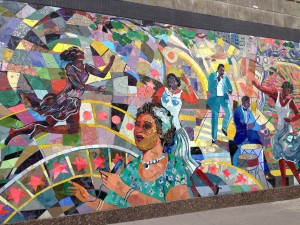In 1903, W.E.B DuBois lamented that “the double-aimed struggle of the black artisan…could only result in making him a poor craftsman” (The Souls of Black Folk 4). His claim was that the dueling aims of proving the race’s worth to whites and also of honoring the authenticity of the black experience pulled the black artist in two different directions such that he became mired in a limbo of stunted artistic growth. Two decades later, Alain Locke ushers in a new generation of black artists who have effectively overcome such crippling and wasteful double striving. In “Negro Youth Speaks,” Locke celebrates the accomplishment that “our poets no longer have the hard choice between an over-assertive and an appealing attitude” (48). Locke declares that the New Negro artists have relinquished past generations’ futile efforts to adopt a voice representative of the African American race as a whole, choosing now to speak as individuals. The black artist is no longer a spokesperson who misrepresents his race by trying to present a sort of average or showcase an ideal; rather, he now expresses his own pure experience, embracing “the virtue of finding beauty in oneself” (52). James Weldon Johnson confirms this movement away from a group or gang mentality, attributing the change to the unique situation of Harlem within New York City. Unlike the rather insular ethnic enclaves of other metropolitan areas, the condition of Harlem lends the Negro “the opportunity for individual expansion and individual contacts with the life and spirit of New York” (310), encouraging the sort of individual artistic expression that Locke recognizes as novel.
Locke does not see this individualization as a fragmentation or weakening of the Negro effort. He maintains that shared social pressure has produced a race “emotionally welded as others cannot be” (47). So even if black artists move away from group expression, there will always be something uniting their work, which Locke describes as the “folk-gift” (48) characterized by “cosmic emotion” (50) and the “closeness of an imagination that has never broken kinship with nature” (50). Indeed, Locke recognizes the success of the New Negro efforts to make a “contribution to the general resources of art” (51), listing as evidence black artists’ “first novels of unquestioned distinction, first acceptances by premier journals whose pages are the ambition of veteran craftsmen, international acclaim, the conquest for us of new provinces of art” (49).
In this way, the Harlem Renaissance marks the moment at which the Negro sheds his status as the DuBoisian ‘Other’ and becomes a Casanovan ‘Outsider,’ able to perfect the art of the center and bend it to his own needs. Take for instance Claude McKay’s “The White House” in which the poet hijacks the form of the Shakespearian sonnet, whose theme usually involves love and romance, to expound upon the quite antithetical subject of hate. Or look at Richard Bruce Nugent’s “Sahdji,” which has the same experimental form as other works of High Modernism yet takes as its subject not the urban society life of say Woolf or Joyce but instead delves into Africa and its passions. By 1925, then, the Negro has matured to knit himself into a rather distinguished place in the fabric of modern culture and art.
Also, on a slightly related note, I was briefly in Harlem last week and wanted to share this colorful, jazzy mosaic I saw on the side of a building (at the corner of 125th St. and Frederick Douglass Blvd). It’s called “Spirit of Harlem,” created by Louis Del Sarte in 2005.
